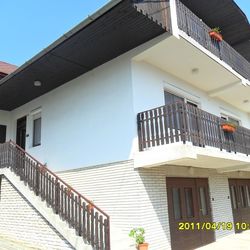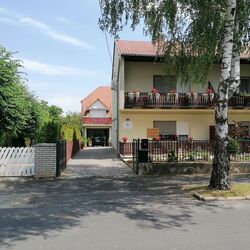

Three cows, two hands, and a story rewritten every morning
In a former press house on the Rezi vineyards, it's no longer wine aging, but cheese. Under the hands of Róbert Cserép, smoked parenyica, spiced gomolya cheese, and sweet whey cream are crafted daily. At dawn, while others are still sleeping, Robi is already in the cheese workshop: pasteurizing, curdling, stirring, shaping, smoking, packaging.
CseroSajt's story isn’t about an inherited craft passed down through generations — it’s about a bold change, a conscious decision, and a lot of relearning. You can taste the cheeses right on the farm, surrounded by peacefully grazing cows and the rolling hills of Rezi vineyards.
From IT Specialist to Cheesemaker
Robi used to work in IT, but eventually grew tired of screens and enclosed spaces. Drawn by the tranquility of a nature-based lifestyle and the desire to create with his hands, he turned to cheesemaking.
“Every morning, before I start, I stand in front of the workshop. The cows graze quietly, the mist slowly lifts, and on colder days, you can even see their breath. That’s when I know I’m in the right place.”
A lifelong resident of Rezi, it was only natural for Robi to start his cheesemaking venture here. He began with just two liters of milk, making cheese as an experiment for his family. Positive feedback quickly showed him that others also appreciated his handcrafted, small-batch cheeses. What started as a passion project has now grown into a business — Robi even has help today.
After numerous courses, trials, and failures, he transformed the old press house into a compliant, yet still artisanal, cheese workshop. Its essence, however, remains unchanged: handmade, close to nature, and close to people.
Cheese you’ll remember
CseroSajt offers fresh plain and spiced gomolya cheeses, along with hand-stretched parenyicas in various flavors. Robi also makes a creamy, sweet whey spread that’s denser and richer than yogurt, offering a unique taste experience.
All cheeses are made from gently pasteurized milk, preserving their natural nutritional value. Robi carefully selects his rennet and bacterial cultures, using only natural, additive-free salt. Flavors are thoughtfully chosen: red onion, ham, garlic, wild garlic, sun-dried tomatoes, dried cranberries, chili — all-natural, often homegrown.
Parenyica is hand-stretched, shaped, filled, and smoked with beechwood, creating its signature mildly salty, smoky flavor, which has become a hallmark of CseroSajt.
No preservatives, no additives — just honest craftsmanship.
No two cheeses are alike
At CseroSajt, you’ll never taste two identical cheeses. Variations are part of the charm, born from artisanal methods and nature-friendly animal husbandry. Though Robi follows his trusted recipes, factors like weather and the grass composition the cows graze on can subtly influence the texture and flavor of the cheese. As Robi says: “Cheese is as good as the milk. The milk is as good as the animal. And the animal is as well as it’s cared for.”
Currently, three cows graze on Rezi hill: two Magyartarka and one Kárpáti Borzderes, named Rezeda, Pipacs, and Jázmin. We encourage you to taste CseroSajt products and, if possible, visit the farm to see the cheesemaking process up close — and meet the cows too.
Product highlights
Parenyica – Hand-stretched, beechwood smoked
Did you know parenyica originally comes from Slovak shepherds in the Tatra Mountains? From there, it conquered the world — and today, it’s made right here on Rezi hill. CseroSajt parenyica is crafted from fresh milk, gently pasteurized, then hand-stretched and rolled into shape using traditional methods. The base version is mildly salty, with a firm yet elastic texture, and smoked with beechwood, which imparts a distinctive yet smooth flavor. No preservatives or additives are used — only natural, mineral-rich salt. You can also enjoy parenyica in various flavors: red onion, ham, garlic, wild garlic, sun-dried tomatoes, dried cranberries, and chili.
Where to find CseroSajt:
- 8373 Rezi, Kiscomai Road, Parcel No. 2622
- Google Maps
More information & Contact:
Imagine a tropical sea where the dolomitic peaks of the Keszthely Hills now rise. The landscapes we consider timeless are, in fact, fleeting guests on Earth’s ever-changing stage. How does a shallow tropical sea become Hungarian highlands? Why does dolomite crack? And how does this still influence local farming today? Travel back millions of years into a story written in stone. Mountains, plains, islands, seas, rivers, and lakes may appear permanent within a human lifetime — but from Earth’s perspective, they are only temporary scenes. The rocks that form our planet’s surface are constantly in motion. Like the shattered shell of a boiled egg, tectonic plates drift endlessly atop the semi-fluid mantle beneath them. Some crash together or sink beneath one another to create towering mountain ranges, while others subside, forming deep trenches or basins that may fill with water. That’s how the dolomite and limestone now forming the Keszthely Hills were once deposited — in the shallow waters of an ancient tropical sea, thousands of kilometers from their present location and long since gone. The scene would have resembled the crystal-clear shallows of today’s Bahamian paradise. While the northern block of the Keszthely Hills is made of relatively young (a few million years old) volcanic rock, the southern section — including Rezi and Cserszegtomaj — is dominated by much older dolomite, formed in those ancient tropical seas. Alongside widespread formations of so-called Main Dolomite, small patches of Rezi Dolomite can also be found — dating back over 200 million years. The Keszthely Plateau is dissected by a north–south valley system and crisscrossed by micro-tectonic fault lines. Due to the shallow topsoil and varied terrain, more than 70% of the area is forested. Its karst surface experiences year-round water scarcity and has unique ecological features. The plateau is divided by intermontane basins and bordered by deep tectonic fractures (such as the Hévíz and Ederics faults), making the area seismically sensitive. Soils formed on the debris of weathered dolomite provide the natural foundation for land use in the region. Several of our local producers cultivate land along the western edge of the Keszthely Plateau, where farming is defined by the proximity of a highland landscape — a plateau formed of horsts rising 350–440 meters, framed by tectonic fault lines.
The Surface: Only Seemingly Permanent
Volcanoes in the North, a Tropical Sea to the South
Geology and Today’s Land Use













